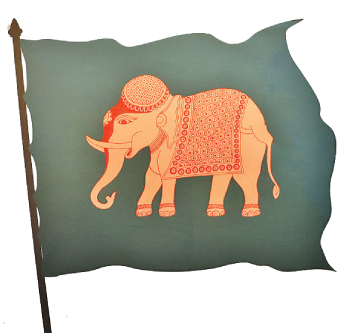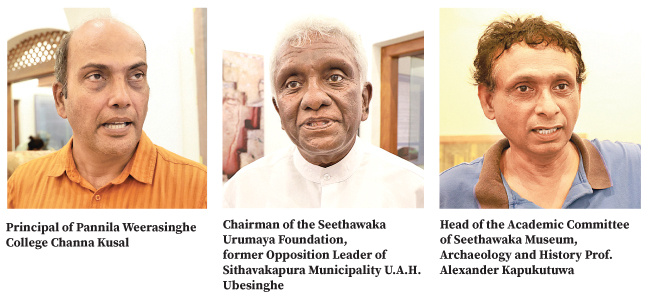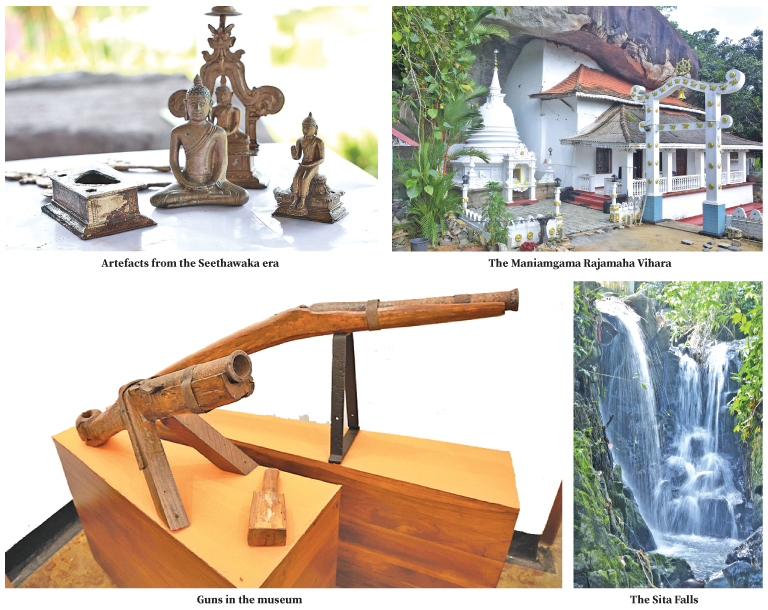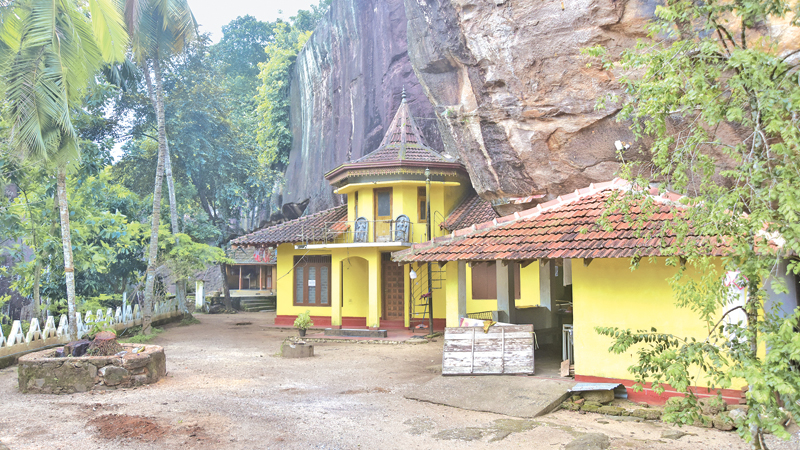The Seethawaka Museum will be opened by Prime Minister Dinesh Gunawardena, Minister of Transport, Highways and Mass Media Dr. Bandula Gunawardena and Ministers at 3.00 p.m. today (July 21).
The Seethawaka Museum includes historical information dating back to the prehistoric era as well as places of archaeological value, exhibits of scenic locations and historic replicas, documentary videos, paintings of warriors and key events of the Seethawaka era among other features.
The Seethawaka kingdom emerged following the dethroning of Vijayabahu in 1521. King Vijayabahu VI, who reigned in Kotte had three sons from his first marriage, Bhuvanekabahu, Parajasingha (Raigam Bandara) and Mayadunne. After the death their mother, King Vijayabahu VI married a princess from Keerawella’s lineage and she came with her adopted child named Deva Rajasinghe. The new Queen conspired to persuade King Vijayabahu to destroy the three children of her first marriage and make arrangements for Prince Deva Rajasinghe to ascend the throne.

A replica of
King Rajasingha’s flag
After the conspiracy was revealed, the three princes requested the help of a king who reigned in the highlands and surrounded the capital and palace. They hired an assassin named ‘Salaman’ to kill their father and divided the kingdom of Kotte into three parts to be ruled among themselves.
Accordingly, Kotte went to Bhuvanekabahu, Raigama to Parajasinghe and Seethawaka to Mayadunne. This historical event was known as The dethroning of Vijayabahu (Vijayaba Kollaya) and was the beginning of the Kotte Kingdom.
Under Mayadunna, Seethawaka became a kingdom that spread over a considerable area.
Turning point
The Seethawaka kingdom boldly resisted the Portuguese, earning it a special place in Sri Lankan history. The Battle of Mulleriyawa in 1562 is an important turning point where the Portuguese, being the most powerful army in the world at the time, inherited its worst defeat in the East.
However, it seems that Seethawaka has not been given much importance. Although its existence was limited to seven decades, many people have little knowledge about Seethawaka’s heritage, including its heroes, service to the Buddhasasana, literature, Angampora martial arts and Ayurveda.
The museum has been built to preserve this historical heritage. The museum will provide visitors with historical information dating back to the prehistoric era as well as displays of places of archaeological value and scenic beauty. The museum includes a number of exhibits that include interactive replicas and models of the Seethawaka era, paintings of warriors and key events during that era, documentary videos and other elements. Under the direction of the Prime Minister’s Office, the Central Cultural Fund (CCF), the Department of Archaeology, the Department of Botanical Gardens, Sri Lanka Railways and other Government institutions and voluntary organisations including the Seethawaka Urumaya Foundation, which has been active for a long time, has made this museum possible.

The prehistoric artefacts found in Kuruvita Batadombalena, Pahiyangalalena, Kukuleganga, Neravana Galge and Kegalle Alu Lena will testify that the area around Seethawaka was inhabited since the Mesolithic Age.
After the approval of the Cabinet Paper jointly presented by the Prime Minister, Minister of Transport, Highways and Mass Media Dr. Gunawardena, Buddhasasana, and Minister of Religious and Cultural Affairs Vidura Wickramanayake, a historic building located on land owned by the Sri Lanka Railway Department adjacent to Avissawella town was refurbished to house the museum. This museum has been constructed after taking over the building to the CCF. Seventeen million rupees was allocated for its construction.
According to the Cabinet proposal, an expert committee headed by Prof. Alexander Kapukotuwa was appointed to construct the museum and the committee representatives gathered information for this museum after an extensive study conducted in Seethawaka and its surrounding areas.
Seethawaka’s heritage
Prof. Kapukotuwa of the Department of History and Archaeology of Sri Jayewardenepura University and head of the academic committee of Seethawaka Museum, said that efforts have been made to preserve Seethawaka’s heritage through the Seethawaka Urumaya organisation.
“Prime Minister Gunawardena paid special attention in this regard as soon as he took office. Work commenced on preserving Seethawaka’s heritage. A dormitory building belonging to the Railway Department was used for that purpose. Even if it started like that, there was not even one whole object. And there was no way to get it. But the dedicated people contributed to the construction of this museum. By now, all the basic steps required for the museum have been taken.
Even the paintings of King Mayadunne and his son King Rajasingha were made to respect those monarchs. Because he did not know about the king’s form properly, he studied historical accounts for a long time to make the renderings.
Even the flag of King Rajasingha had been recreated for this museum. Much information about the history of the Ratnapura areas close to Seethawaka has also been included.
A good understanding of prehistoric humans can be obtained at the museum. Even dinosaur fossils have been found. Also, oysters that are believed to have been eaten by prehistoric humans are also displayed in this museum.
A model of the oldest elephant lamp has been featured. The lamp is unique because it is designed so that oil from the elephant’s phallus pours out when the lamp is heated. It is believed to belong to the 12th century.
Replicas of cannons
It also contains two replicas of cannons known as Koditutukku. One of those two guns is still in working condition in Medagoda Pattini temple and the other gun is buried in Maniamgama Rajamaha Vihara. Both of them have been identified as being in the time of King Rajasingha I.
Many things unique to Seethawaka are on display in this museum and the railway ticket stamping machine used at the Kuruwita railway station when the Kelani Valley ‘little train’ was running and a tile from a railway station in the year 1865 are included here.
Channa Kusal, principal of Pannila Weerasinghe College, who worked hard to build the museum, is also engaged in searching for many artefacts belonging to the Seethawaka era. He has been exploring places including Barandi temple and has arranged to donate many antiquities to the museum.
A museum like this is something that the country needs. The efforts of the Prime Minister should be appreciated. It is not just us but also the country’s fortune to do this work within four months. School students and others who visit this museum are also encouraged to go out and explore Seethawaka.
Most of these historically significant locations are within 10 to 15 km from the museum. Even today, there is a historical temple where the first paddy harvest is husked and offered before a grant pageant is held. That is Maniamgama Rajamaha Vihara. The Duruthu Karal Punya Mahotsavaya is a one of a kind festival held in Sri Lanka and information about all this can be obtained at the museum.
Chairman of the Seethawaka Urumaya Foundation, former Opposition Leader of Seethawakapura Municipal Council, U.A.H. Ubesinghe said that Seethawaka heritage exhibitions started some time ago and it was successfully held in Avissawella, Padukka and Kosgama areas.
Tourist areas
“We hoped to show Seethawaka’s pride. We have been committed to this for many years. It got results. We had previously looked at three locations for a museum. But we could not do this work in those places. You can learn about many hidden gems such as Angampora and Ayurveda unique to Seethawaka at the museum. Also, there are many places that can be developed as tourist areas. We have to put in work for that. These are all our heritages,” he said.
Visitors to the Seethawaka Museum can visit many places of natural beauty and historical places including Sita Cave, Sita Falls, Barandi Temple, Hakurugoda Rajamaha Vihara, Maniamgama Rajamaha Vihara, Rajasingha Tomb, Raja Lena, Seethawaka Palace Ruins, Dahanwaka, Yakahatuna viewpoint.
It also contains many details including the route taken to Yatianthota and Opanayake in the early days of the Kelani Valley Railway. A model of Medagoda sannase has also been completed here and information can be obtained about the worship of goddess Pattini in Seethawaka. In particular, there are evidences that 48 Pattini temples were spread over Seethawaka and the museum contains information about the decline of the kingdom and the era up to today.
The museum opens doors to localities in Seethawaka besides archaeological sites. The museum is looking for artefacts with historical significance and archaeological significance or replicas related to the Seethawaka era and are looking for donations that can benefit future generations.

Pix Dushmantha Mayadunne and Kusumpriya Rajapaksa
Translated by Jonathan Frank









